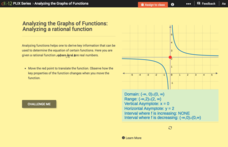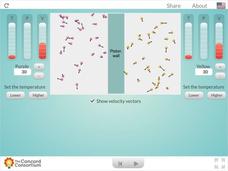Cornell University
Scaling Down: Effects of Size on Behavior
Two activities explore the concept of size, especially small sizes down to the nano. Scholars practice determining volume, mass, and density and calculate exponential increases and decreases. They then predict and test the effect of size...
CK-12 Foundation
Greatest Common Factor Using Lists: Tiling the Kitchen Floor
Use a combination of tiling a rectangle to find area and find the greatest common factor of the lengths of two sides and the area they create. Pupils increase and decrease the sides of the rectangle before answer five questions about...
CK-12 Foundation
Applications of Probability: What Are the Odds?
Improve your chances of understanding odds. Scholars use an interactive spinner to increase and decrease the number of favorable and unfavorable sections on the spinner. This spinner helps them learn about odds.
CK-12 Foundation
Analyzing the Graphs of Functions: Analyzing a Rational Function
Shift the function and transform the key features of the graph. By translating the graph of the rational function, class members find out how the key features alter. Pupils determine the domain, range, asymptotes, and intervals of...
Concord Consortium
The Volume-Pressure Relationship
Pressure and volume are in a relationship, but what is the nature of it? High school scientists discover the link between the volume of a gas and the pressure it exerts using a simulation. The resource tracks pressure in a sidebar as...
CK-12 Foundation
Fraction Rounding to the Nearest Half: Beaker Math
Rounding fractions is the focus of a six-question interactive designed to boost concept proficiency. A measured beaker's water level increases and decreases as mathematicians move the tool to represent specific fractions. Questions...
Flipped Math
Calculus AB/BC - Connecting a Function, Its First Derivative, and Its Second Derivative
Uncover what the first and second derivatives reveal about the function. Pupils move beyond sketching graphs to determine what derivatives tell about the function itself. The video reminds learners about particle motion and how to...
Flipped Math
Calculus AB/BC Mid-Unit 6 Review: Integration and Accumulation of Change
Accumulate the content so far. Learners review the content from the first five lessons dealing with accumulation functions. The eight problems go over finding maximums, minimums, concavity, points of inflection, and intervals of increase...
Flipped Math
Calculus AB/BC - Exploring Behaviors of Implicit Relations
Put everything together implicitly. Pupils use their knowledge of implicit differentiation to determine whether a curve is increasing or decreasing or its concavity. Given a differential equation, scholars determine whether a specific...
Flipped Math
Calculus AB/BC - Interpreting the Behavior of Accumulation Functions Involving Area
Accumulation functions should behave like other functions. Using content from Unit 5, pupils analyze the first and second derivative to determine the behavior of an accumulation function. Learners find out how to calculate the relative...
American Chemical Society
Density and Sinking and Floating
Keep your class afloat with a hands-on density lesson. The challenging lesson has learners experiment with different materials to compare their densities. They learn that increasing or decreasing the amount of the material doesn't change...
College Board
Frozen in Time
Take a closer look at increasing and decreasing behavior by zooming in on graphs. An AP® Calculus reference document examines how increasing/decreasing behavior should be considered in terms of intervals rather than points. The resource...
Math Worksheets Land
Percent Error and Percent Increase - Matching Worksheet
Calculating percent change is a handy tool to understand sales, discounts, and other numerical changes we come across. Here, worksheet practices percent change and percent error with a variety of problems to let your learners see how it...
Illustrative Mathematics
Baseball Cards
Here is a resource that demonstrates growth and the initial state of an equation. In this case, your class will be looking at baseball collections. How many baseball cards did the collector start out with, and how many were added or...
Math Worksheets Land
Percent Error and Percent Increase - Guided Lesson
When prices and numbers change, can you calculate by how much? Here is a worksheet that introduces the idea of percent change and percent error to calculator how much change the information goes through. Use the worked-out solutions to...
Illustrative Mathematics
Chess Club
When the membership in a chess club changes, it is your mathematicians' job to find out how many boys and girls are attending and the percent change from last year. The activity provides a great compound problem finding the different...
Curated OER
Prosperity and Challenges
Young scholars watch a slideshow about the technological advances in agriculture. After viewing, they complete an index card about one aspect of the slideshow. In groups, they create a cause and effect timeline in which they identify...
Illustrative Mathematics
Comparing Years
Who knew that the Egyptian, Julian, and Gregorian year were different lengths? Your mathematicians will! They will have to calculate the difference between the years in seconds and find the percent change. Using dimensional analysis,...
Chicago Botanic Garden
Calculating Your Carbon Footprint
Unplugging from technology for one day per week will decrease your carbon footprint—are you up to the challenge? Part two in a series of three allows individuals to explore their personal carbon footprints. By first taking a quiz at home...
Concord Consortium
Pressure Equilibrium
All together now! Physical science pupils observe the effects of temperature and amount of substance on pressure and volume of a gas. The interactive resource guides learners through the Combined Gas Law, where they observe changing...
Flipped Math
Exponential Decay
The values keep getting smaller—quickly! Pupils watch a video that contrasts exponential decay with exponential growth from the first lesson in the unit. Learners identify exponential functions that are decaying and create graphs of...
EngageNY
Fluency with Percents
Pupils build confidence working with percents as they work several types of percent problems to increase their fluency. The resource contains two sets of problems specifically designed to build efficiency in finding solutions of basic...
Novelinks
Zach’s Lie: Magic Squares
Individuals match vocabulary words within a magic square, a concept that ties in nicely with math class. The words are all located in Zach's Lie and were specifically selected to increase comprehension of the text. Fifth in a series of...
PBS
The Lowdown — Poverty Trends: What Does It Mean to Be Poor in America?
Here's a resource that's rich with learning opportunities. Future mathematicians investigate the poverty rate in America over time. They use an interactive to compare the poverty rate during the Great Recession of 2008 to other years,...
Other popular searches
- Percent Increase or Decrease
- Percent Increase and Decrease
- Percent Increase Decrease
- Percentage Increase Decrease

























